Pink hydrangea: varieties, planting and care
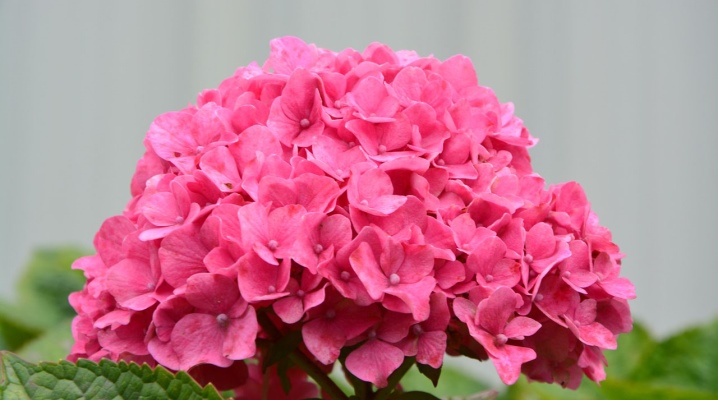
A beautifully flowering shrub is a real decoration of the garden. Pink hydrangea is one of the brightest representatives of flowering bushes, and its features allow it to be grown everywhere. What are the features of a pink hydrangea? Let's characterize the plant from all sides.
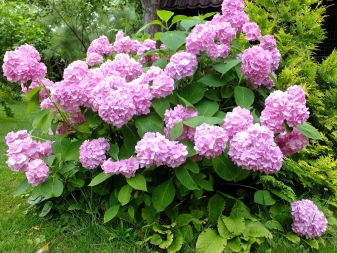
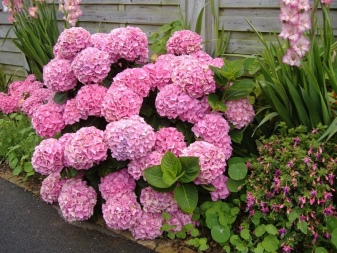
Peculiarities
Pink hydrangea attracts attention with its lush inflorescences. That is why this tree-like bush is so often used both in parks and squares, and in the landscape design of personal plots. This deciduous shrub reaches 1 m in height. The leaves are elongated, emerald green, do not fall until late autumn.
The description of the hydrangea should include a detailed story about its inflorescences. Any species of this plant has a very interesting flowering. Small flowers are located in the middle of the inflorescence, surrounded by larger flowers. This feature gives particular visual interest to both pink hydrangea and other species. Flowering will delight from mid-summer to mid-autumn.
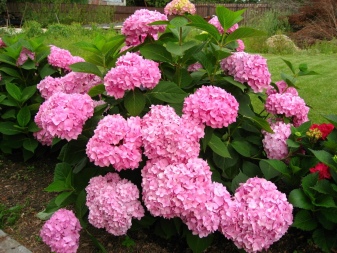
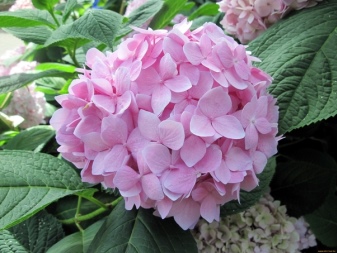
Important! It is the varieties of pink hydrangea that have an amazing feature: its flowers can change color thanks to a special substance - anthocyanin.
If the soil is alkaline, the flowers remain pink. Acidified soil will cause color changes to sky blue.
Types and varieties
Pink hydrangea has many species and varieties. But in the conditions of the Russian climate, such species as treelike and large-leaved hydrangeas showed themselves well. Pink varieties are striking in their variety. Let's consider the most popular ones.
- Large-leaved hydrangea Early Pink in height above one meter, and the diameter of the crown reaches one and a half meters. The inflorescences, like the leaves, are huge - up to 15–20 cm in diameter. The flowers are sterile and range in color from pale pink to purple. Hydrangea loves sunny areas, it is difficult to endure wintering - shelter is required.

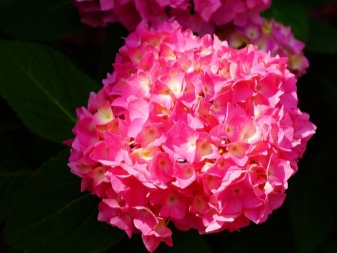
- Hydrangea Pinky Promise got its name from the English expression "swear on the little fingers" apparently because of its compact size. This variety was developed in Holland. This plant is very resistant to environmental conditions, up to 0.8 m high. The leaves are dark green, the flowers are initially white, then gradually change their color to pink during the season.
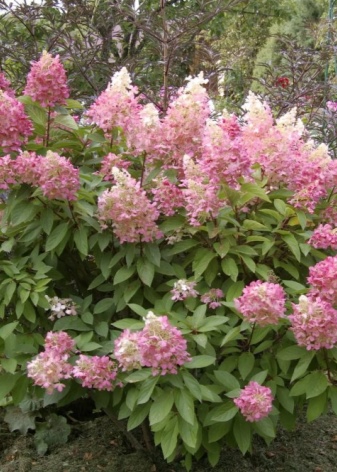
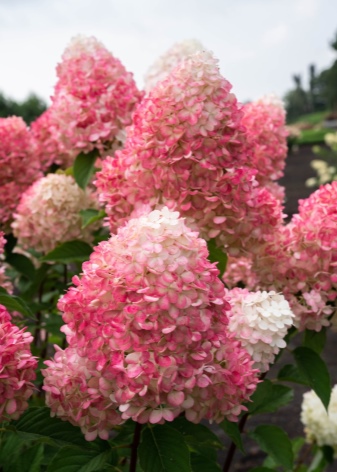
- Large-leaved hydrangea Hanabi Rose. The compact bush grows up to 1 m in height and 0.9 m in width. Flowering is tied on last year's shoots. An interesting shade of inflorescences (purple-pink) makes the variety very attractive for gardeners.
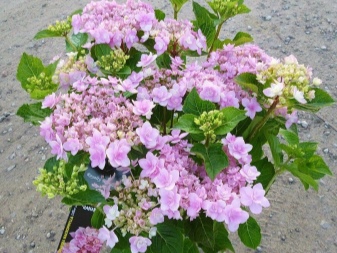
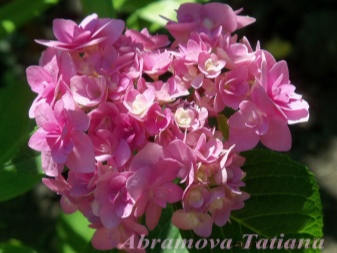
- Hydrangea tree "Pink Anabel" - tall shrub reaches a height of 1.5 meters. As a rule, there are no difficulties in leaving, it tolerates wintering well. The flowers are dark pink when blooming, and then they brighten.
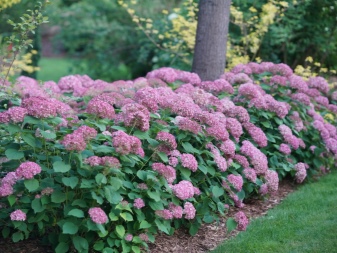
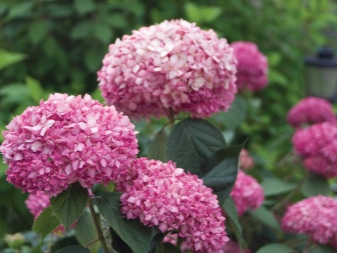
- Panicle hydrangea Touch of Pink. A small bush up to 0.7 m in height and 1 m in diameter. Hydrangea prefers sunny areas, is not picky about soils, but it is better to use humus as a fertilizer when growing it. With strong spring pruning, it produces the most active flowering. The peduncles are openwork, at first white, but then they acquire a pink tint. Often used in group plantings.
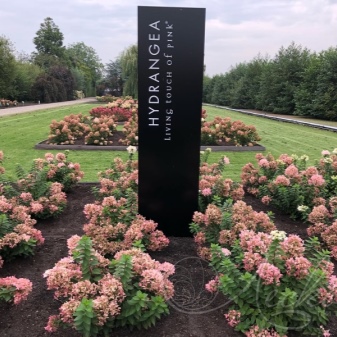
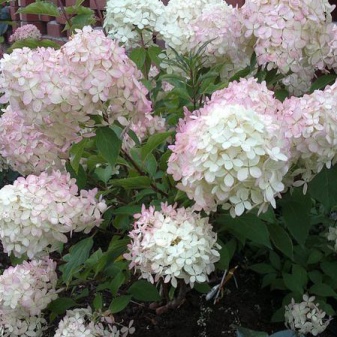
- Hydrangea "Pink pillow" or Pink Pincushion. Winter-hardy and unpretentious variety. It grows up to 1.5 m in height and blooms in the first year after planting. Inflorescences are large - up to 0.3 m in length.The flowers are rare, white and pink. Long flowering provides the bush with decorative effect all summer and half of autumn.

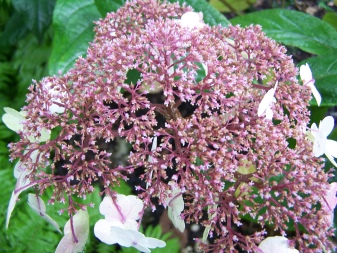
- Hydrangea paniculata "Pink Lady". A very large variety. The height and width of the plant reaches two meters. The branches are so covered with inflorescences that they bend to the ground under their own weight. The leaves are also large, matte, emerald green. Flowers initially appear white, then turn green.
Hydrangea is resistant to drought and frost, but prefers acidic soils.
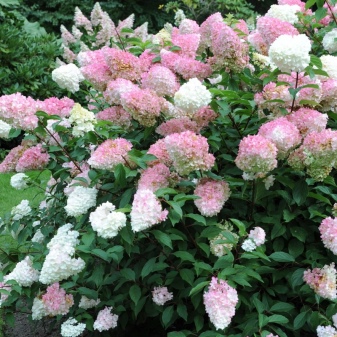
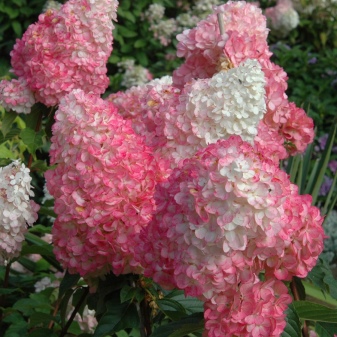
- Hydrangea "Pink Diamond". A large bush can reach three meters in height. The leaves are oval, dark green, have a rough structure. The inflorescences are conical and bloom from early summer to mid-September. At first, they are traditionally white, and by the end of flowering they acquire a coral color. Frost-resistant and unpretentious variety.

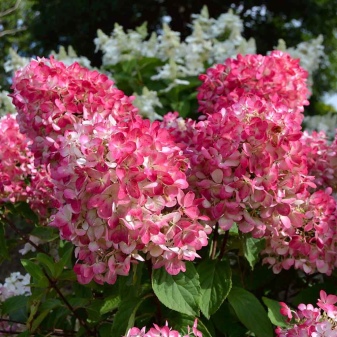
How to plant?
Planting hydrangeas is one of the most important factors in the proper growth and development of a plant. If you choose the wrong place, time and method of planting, you can cripple the bush without waiting for the manifestation of its decorative properties. Planting a pink hydrangea outdoors depends on several factors.
- Planting time is early spring. The ideal time is the beginning of the growing season, when the buds have not yet begun to grow. That is, the ground has thawed, and the average daily temperature has not yet reached 10 degrees. Less often, hydrangea is planted in the fall, at the beginning of September, when there is no way to plant a plant in the spring.
- The place is fairly lit and humid. Constant bright lighting will negatively affect the flowers: they will become smaller. On the street, you can choose a light, but shaded corner near the house or a gazebo or a large tree. Adequate moisture is also very important for a hydrangea, so planting it in slightly low places is encouraged. The superficial root system of hydrangea suggests that neighboring plants must have taproots, otherwise the rivalry will destroy the flowering bush.
- The soil is fertilized and without lime. Although pink hydrangea loves moisture, it is imperative to drain the planting site. Stagnant water will destroy the roots of the bush and cause rot. Before planting, the soil mixture must be fertilized, added peat, humus and river sand in a ratio of 2: 1: 1: 2. Such proportions are optimal for a given tree-like bush.
- The landing pit is wide and shallow. The root system of the plant grows slightly in depth, but it grows quite extensively in width. This feature must be taken into account when digging a planting hole. After planting, the roots should not break off and bend. At the bottom of the planting pit, it is necessary to lay out drainage - expanded clay or broken brick.
- Root soaking is an important part of planting. Before planting, you need to spread the roots and soak them in a bucket of water. This procedure must be completed approximately two hours before planting.
- Neat planting without burying the root collar. Do not bury the hydrangea root collar, as it quickly begins to rot. After planting the plant, the trunk circle must be tamped well.
- Abundant watering after planting. After planting a pink hydrangea in the garden, it must be watered abundantly at the rate of two buckets of water per bush.
Watering should be done carefully so as not to wash out the newly poured soil.
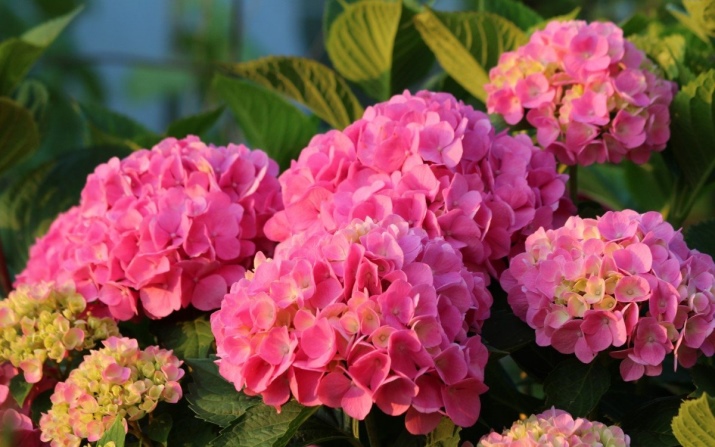

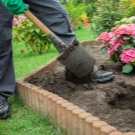
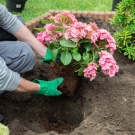

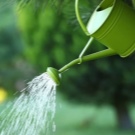
How to take care of it properly?
Hydrangea care is an important part of its beautiful appearance. It is not so easy to grow this bush, almost all flowering shrubs are quite capricious in relation to environmental conditions. The basic rules of care are in traditional agrotechnical measures, but with the condition of the characteristics of the plant.
Top dressing
They begin to feed the pink hydrangea from the beginning of spring, when the daytime temperature has already reached + 10– + 12 degrees. The shoots of this bush give a serious increase - up to half a meter per season, therefore they require additional nutrition. The ideal top dressing is nitrogen.Dilute 1 tablespoon ammonium nitrate with ten liters of water and pour over the hydrangea. The frequency of such feeding is once every two weeks until the end of June. You can alternate with watering with chicken droppings diluted with water (1: 10).
In the middle of summer, the above-described dressings are carried out every three weeks. It is recommended to add superphosphate, potassium nitrate and urea to them. And also for the flexibility of the shoots, you can occasionally water the pink hydrangea with a weak solution of potassium permanganate.
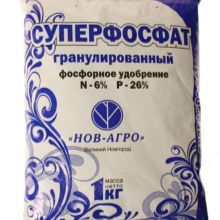
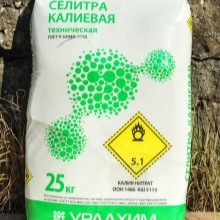
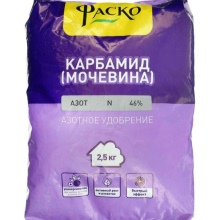
Watering and loosening
Water the pink hydrangea often. It grows quickly and blooms profusely, therefore it requires a lot of moisture. In hot weather, one adult plant will need about 20-25 liters of water at least once every 7 days. In order for moisture to remain in the soil, loosening should be carried out in the near-stem circle of the hydrangea. It is carried out before irrigation with a radius of 0.5 m and a depth of up to 5 cm. During the season, at least three loosening should be carried out.
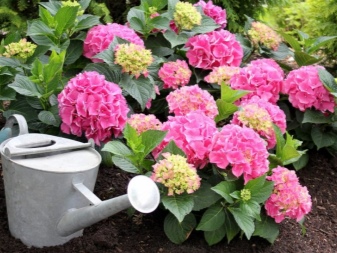
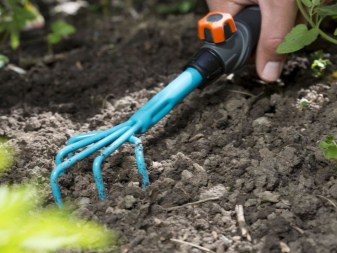
Pruning
In early spring, the hydrangea should be sanitized pruning. You do not need to cut the bush too much, otherwise you can achieve poor flowering. It is necessary to remove only damaged and old branches and only thin out the rest of the crown a little. Timely pruning will help keep the bush decorative. After the beginning of the growing season, you should not prune the hydrangea, as it may begin to dry out. The exception is fast-growing species with a dense crown.
In this case, it is worth pruning again in the fall so that the branches do not break in the winter under the weight of the snow.
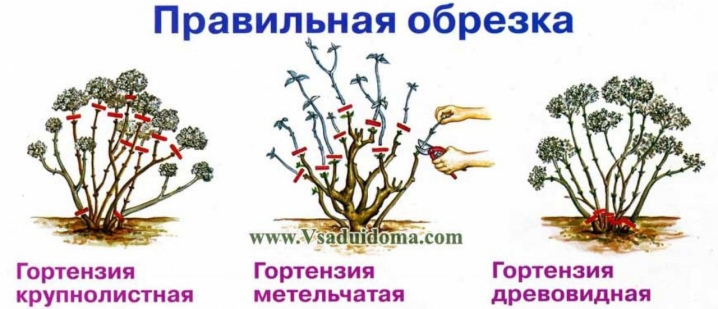
Wintering
Hortense loves warmth. Therefore, before a long winter, it must be covered with a good layer of mulch (about 20 cm), then spruce branches and a film, if frosts are below -20 degrees - a frequent occurrence in your area. Young plants need to be especially carefully prepared for the winter, since they are the ones that endure the cold worst of all.
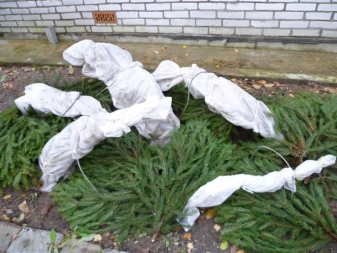

Reproduction methods
Pink hydrangea can be propagated in three ways.
- Seed propagation is very difficult to carry out on your own, and flowering will have to wait for several more years. If it is impossible to apply another method of reproduction, then the seeds are simply sown in March and wait for germination.

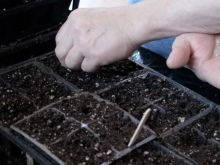
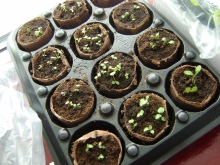
- A common way to get a young plant is cuttings. To do this, select the middle part of the shoot without bud buds and cut it out with a couple of leaves 1 cm below them. The cut should be oblique. Ready cuttings must be planted in a previously watered soil. The site should not be under the scorching sun. After a month and a half, the cuttings should take root. In the same place, the rooted hydrangea should overwinter, only then it is transplanted to a permanent place.
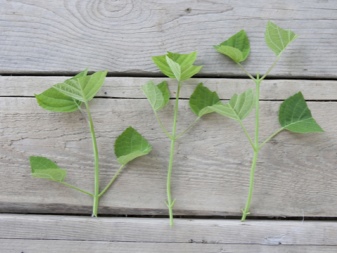
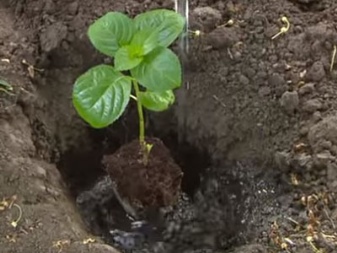
- Reproduction by layering is the easiest thing for amateur gardeners. To do this, young shoots are bent to the ground, fixed with hairpins, watered. And the next year, the rooted branch is separated from the mother plant and transplanted to a new place.
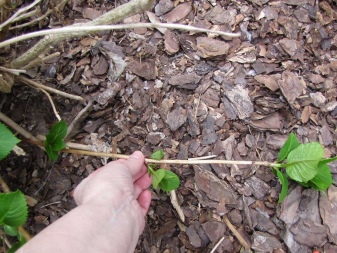
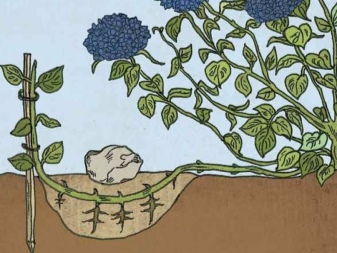
How do I change the color?
Most hydrangeas change color on their own throughout the season. The color change depends on the soil environment. If the soil is acidic, then a blue hydrangea will turn out from a white hydrangea, and an alkaline and neutral environment makes it possible to get a pink hydrangea. Blue pigment also appears when there is a sufficient amount of aluminum in the soil. To obtain this color, you need to make a solution of aluminum sulfate and water the plant with it. The procedure should be carried out regularly.
Pink hydrangea is much easier to obtain. The simplest folk remedy is chalk. It is pounded and added to the soil, most often along with dolomite flour. In indoor hydrangeas, it is even easier to get and fix a pink color. To do this, you need to use a substrate, not soil, for example, peat.

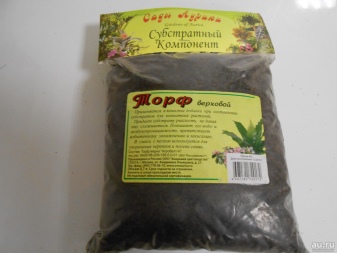
If the open field contains a lot of aluminum, but you want to get a pink color, you need to apply fertilizers with phosphorus. It reacts with metal and neutralizes it.
It should also be remembered that peat, often used as a substrate for indoor hydrangea or as a mulch for a plant in an open field, contains enough aluminum in its composition to color the inflorescences blue.
Growing problems
Since pink hydrangea is a flowering shrub, the main problem that worries gardeners is “problems” with flowering. Sometimes the plant gives only foliage, at first glance it is not clear why this happened. The reasons for this phenomenon can be very diverse: unsuitable environmental conditions, rare feeding or even neglect of them, and others. But the most likely reason for the lack of flowering is heavy pruning. If you overdo it with the spring "haircut", then the hydrangea can intensively engage in the development of its own root system, perceiving pruning as a signal of external unfavorable conditions. It is also important to remember that transplanted plants may not bloom in the first year, as they recover from stress.
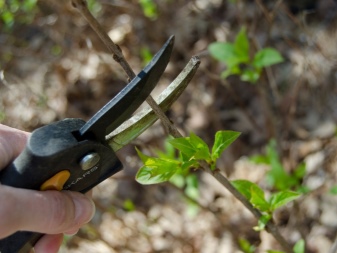
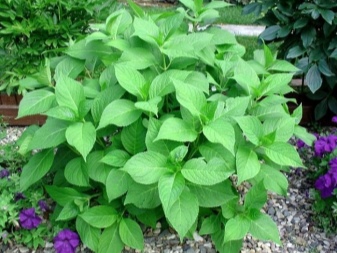
Hydrangea leaves often turn yellow. This problem appears as a result of a lack or excess of light or moisture, too low acidity of the soil, drafts or insufficient amounts of nutrients in the soil. It is rather difficult to resolve the issue with yellowing of the leaves, because it is not always possible to immediately determine the reason. Therefore, you need to gradually try to improve the growing conditions for the shrub and observe the foliage. If any measure has shown effectiveness, it is necessary to remember the cause of the problem with the leaves and neutralize the negative factor.
Pink hydrangea is resistant to diseases and pests, but sometimes it suffers from powdery mildew, from which the leaves also turn yellow and become overgrown with a whitish bloom. You can deal with it in the old and proven way - Bordeaux liquid. This shrub can be chosen by slugs. A layer of pine sawdust mulch and industrial remedies against these pests will save them from them. In pursuit of a quick color change, many gardeners too often water the hydrangea with substances that change the color of the inflorescences. It must be remembered that an abundant application of aluminum or chalk, as well as other catalysts for changing the color of flowers, can harm the roots of the plant.

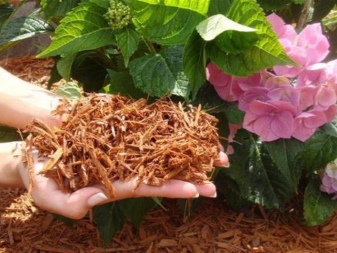
For information on how to grow a pink hydrangea, see the next video.



































































The comment was sent successfully.